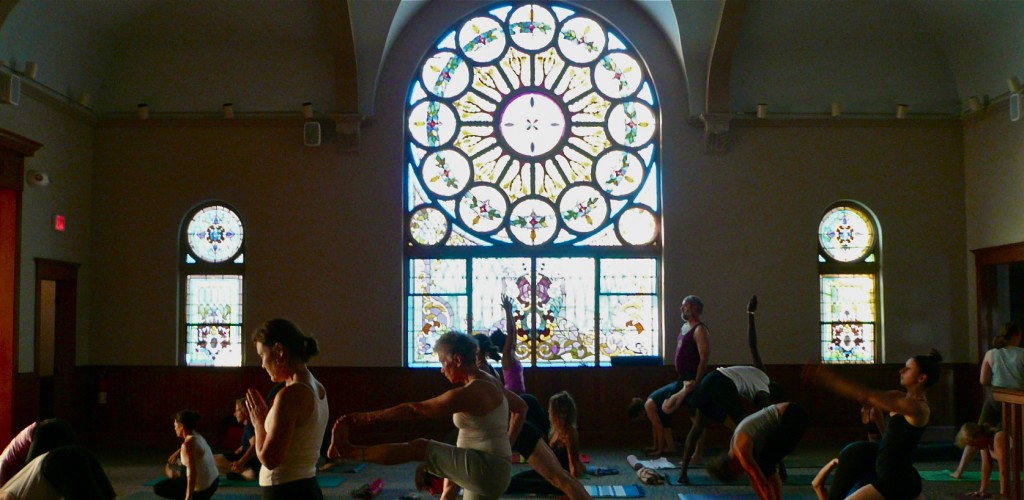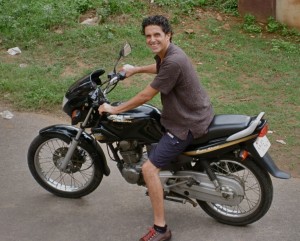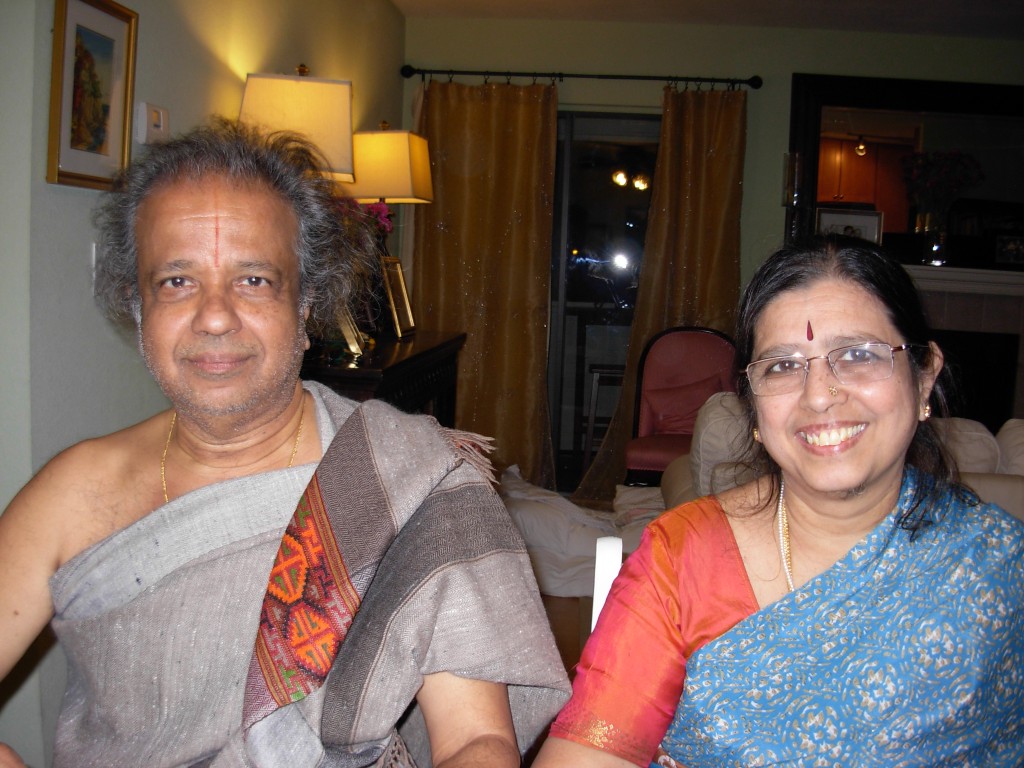Thank you, AY:A2 students, for your support of the apprentices I’m training. Your generosity of spirit affects them in very good ways. Because several of you have said you’d like to hear about what I’m up to with this apprenticeship stuff, and because I want you to feel that you’re part of this, I’m going to dish. What we’re doing is actually somewhat bold, if not a tiny bit subversive.
When AY:A2 incorporated in 2011, I gave it a dual mission. First and most important, we support yoga practice with the resources of a teacher, a method, and community. Second, AY:A2 will provide teaching mentorship in a way that benefits not just our shala but the wider ashtanga community and the future of the practice.
The second mission has attracted much of my creative energy for the past year. In return for this creative investment, training apprentices has begun to give me all sorts of happiness as well as confidence in the future of the ashtanga practice.
How AY:A2 can serve the future of the practice.
For ashtanga teachers, transitioning from sadhana to seva (from self-focused practice, to service) can be weird. It can stunt one’s growth dramatically if done without sufficient (1) preparation as a student, and (2) support from teachers and community. When this transition is made because the student puts herself in the teaching role, and not because her own teachers identify her as sufficiently skilled and prepared to teach, the challenges just mentioned are multiplied.
(Subtext: do not get in to ashtanga teaching unless you full-on cannot avoid it. Resist!! Don’t give yourself over to it unless you basically have to do it in order for your own practice to grow, and unless you have tons of support.)
Given these challenges, most teachers need active, invested mentors to whom they are accountable. (I do.) They need a (1) clear method and (2) a sense of history to keep from getting confused. They need to have strong equanimity and mental clarity, so they can (1) stand outside today’s “yoga†market and culture hype and (2) influence that culture positively.
Teachers need to be able to identify, and resist, the ego’s urge to use teaching to feed root chakra needs: money, sex, power, and attention.
(Subtext: yoga BS, and yoga scandals, happen when teachers don’t have all the support they need. Or when they fail to realize that they actually do have sufficient money, sex, power and attention – and thus they constantly grasp after more and more of the same. This happens when we don’t have anyone to call us on our, well, crap.)
It’s going to take time, but the vision is to find some mature practitioners, and offer them exactly this sort of support. When they’re done, they can use this training however they choose. So far, we’ve found that just going through the apprenticeship process is a great joy for me, and inspiring for them. We work sort of hard. But in the big picture, it gives more energy than it takes.
Apprenticeship here is invitation-only, merit-based, and free.
I look for compassion, open minds, and relaxed self-discipline. All apprentices:
(1)Â have been practicing daily without a break for at least two years and preferably longer,
(2)Â deeply understand the ashtanga method on its own terms, and
(3)Â have been drawn intuitively into some sort of meditation practice without any push from the outside.
(Subtext: don’t ask.)
Before they begin apprenticing, I ask for three commitments:
(1) continued daily practice (before teaching, even when that means getting up at 3am),
(2) full-on forgiveness regarding any lingering issues with any previous yoga teachers, and
(3) a commitment not to get romantically or sexually involved with any student in the shala.
After they start apprenticing, I ask that they meditate daily. Apprentices assist about one day per week (so you as students get used to them). And they meet with me 2-4 times a month for an informal talk like those I used to have with Dominic after assisting him. Unlike just about everyone else, apprentices have my phone number and a high level of access to my energy. They’re encouraged to start exploring new questions and lines of study regarding yoga. I get interested in whatever interests them, so that I can be an interlocutor regarding their individual lines of historical, physiological, spiritual or whatever inquiry.
Apprenticeship ends.
Apprentices get 200 hours from AY:A2. After the first 100 hours of classroom assisting, they do have the option to choose to continue assisting me for another 100 hours or so if they’re still learning from it. However, this can’t go on forever. Somewhere around the 200 classroom hour threshold (300 hours total), AY:A2 starts paying apprentice teachers.
This goes to the point of the motives for the apprenticeship program. The motivation is to support great teaching.
My legacy is to avoid apprentices as much as possible. For example, when I started assisting Dominic, he had about 60 students per day at the flagship Yogaworks in Santa Monica. Many people in that scene wanted to assist him, because he was a yoga somebody and his vibe was so crackling-intense, ego-blinding and badass that being around him was an education in itself. But… he wasn’t interested in assistants. Same goes for Sharath – it was only after much resistance that he allowed authorized teachers to assist him in the shala in Mysore, and he only did this as an alternative to the residential teacher training program, when he discontinued it. So that’s where I’m coming from. I’m not looking for help in the Mysore room.
But, working with apprentices excites me tremendously. This might be a little weird. Training apprentices does take a lot of work and it does generate new responsibility for me to carry. Eh, whatever. It gives me a chance to do even more yoga, and to fill my own need to have a positive impact on the world. If this stuff didn’t excite me so much, I’d find an easier way to train assistants or just not bother to do it at all.Â
This program is politically conscious.
The majority of yoga teachers are exploited. Exploiting them is easy because they’re inexperienced as practitioners and poorly trained as teachers. But exploitation, inexperience and poor training don’t help anyone – not really.
I had to read Das Kapital backwards and forwards to understand labor relationships well enough to see that exploitation of yoga teachers (combined with expensive teacher trainings that flood the labor market) is where studios make a profit. But most people are quicker studies than me: you can see how the industry works. (I actually enjoy teaching for little or no money. But that’s another matter, related to the way I define my own “profits,†given that my basic needs are already fully met.)
But here’s the thing. Trying to pretend you know what yoga is when your practice is not fully developed is a formula for arrested development. Thrusting a person into this job for matters of convenience is not cool. It’s the reason western yoga is full of elementary-level instruction trying to pass itself off as something more by adding special effects.
(Subtext: when you meet someone who wants you to teach regardless of whether you’re ready, and for matters of their own convenience, is that your teacher? Do you deserve better?)
Teacher training and the KPJAYI.
A note about a promise I have made to my teacher, R. Sharath Jois. Apprenticeship here is a support to (not a substitute for) travel to the main ashtanga school in Mysore, India. Like all of us blessed to teach by the KPJAYI since about 2007, I have promised not to participate in western style teacher trainings. We sign a contract: no teacher trainings.
A KPJAYI diploma is a basic qualification for starting one’s own, independent, full-on Mysore program. It is a professional criterion in a field with low barriers to entry. Those who take leadership positions in this profession without it tend to have difficulty feeling fully supported in their work. This may come out in all sorts of ways. And it may be passed on to students in still other ways. It is so hard to grow when we feel we have to defend our basic territory. I want more for AY:A2 apprentices. It is good to be fully nourished in your personal practice, and in your teaching practice.
Besides, the transmission thing is no joke: spending time on the ground in Mysore brings a particular taste of BS-transcending, firey, relaxed excitement to a teacher’s vibe. Making the sacrifices required to get there simplifies life and priorities – which one has to do anyway in order to run a Mysore program without being crushed under its weight.
Love.
On that note, a restatement of the obvious. Training apprentices in a focused, personal, high quality way floats my boat. I do it for kicks. It’s just the particular way that my excitement for the practice is manifesting now. Within the parameters I have set, the program will change over coming years. And over time we will bring in visiting teachers who have their own unique approaches to apprenticeship.
My own training in the beginning was unsystematic, informal, random, and hilarity-imbued. And this was perfect! I’m still being mentored in my teaching, in many ways too intimate or subtle to mention, and much too specific to reproduce for others. There’s no one way to learn to teach.
This just happens to be my way of taking maximum joy in my work. So, again, AY:A2 crew, thank you for being awesome to the apprentices. You are implicit teachers to them, and I’m glad to see you enjoying their presence in the room.
APRENTICES.
Rachel Garcia. Rachel was introduced to Ashtanga yoga in Reno, Nevada in 2007. She has practiced under the guidance of Angela Jamison six days a week since April, 2011. She completed a 200 hour teacher training course through the Sivananda Yoga Vedanta Center in 2005 and has taught Sivananda and vinyasa style yoga classes since 2006. In April of 2012, she began assisting, and then co-teaching, the Mysore Light class on Sundays, and in September of the same year she began assisting one day a week in the regular Mysore style Ashtanga yoga classes. A licensed massage therapist, she is also a student of kiniesiology at the University of Michigan.
Rose Tantraphol. I’m fuzzy on exactly when I stumbled into my first led ashtanga class, but I still distinctly remember the feeling of intrigue, of knowing I needed to return. There weren’t shalas where I lived in western Massachusetts, so I did what I could based on books (hint: not much). I had the chance several years ago to start taking led classes a few times a week, but that wasn’t enough to truly manage the chitta vrittis. In August 2011, more than a decade after that first taste of ashtanga, I found my rhythm and started the traditional Mysore practice schedule. The six-day-a-week ashtanga practice has been my Rosetta Stone, helping me decode how to eat more mindfully, meditate more consistently, keep work stress at bay, and simply feel more comfortable in my own skin.Thanks to AY: A2, I’ve traded in my night-owl proclivities for early-bird habits, which include making the hour-long drive from Lansing to Ann Arbor to practice four or five times a week.Passions other than ashtanga? Blogging at YogaRose.net and salsa dancing with my husband, Scott. (Salsa dancing at the Phoenix Center, by the way, is how I found Angela. Seeing that little calendar posted on the bulletin board would change. my. life.)
Kasia Glanowska…
Tim Visser. Tim began practicing yoga in 1990, when curiosity brought him to a class taught by Elizabeth Bunker during his last year of law school.  Living in Boston at the time, he had the opportunity during that decade to study extensively with senior Iyengar yoga teachers Karin Stephan, Patricia Walden, and Peentz Dubble.  He also studied with Barbara Benagh, with her unique style inspired by Angela Farmer, and taught himself the ashtanga sequence from Beryl Bender-Birch’s “Power Yoga” book shortly after its debut in 1995.  This century, after moving  back to Ann Arbor, Tim has gradually intensified his focus on Ashtanga, first at the weekly Inward Bound class led by Jonathan Tyman, then almost daily at the former Yoga Shala in Ann Arbor where he also participated in teaching led and Mysore-style classes, next as a founding member of the A2shtanga yoga cooperative, and finally (and gratefully) with the AY:A2 program as it was conceived and gradually grown after Angela’s arrival here in 2009.  He is thankful to his wife Jimena and kids (Miranda & Owen) for their support of his householder practice.


